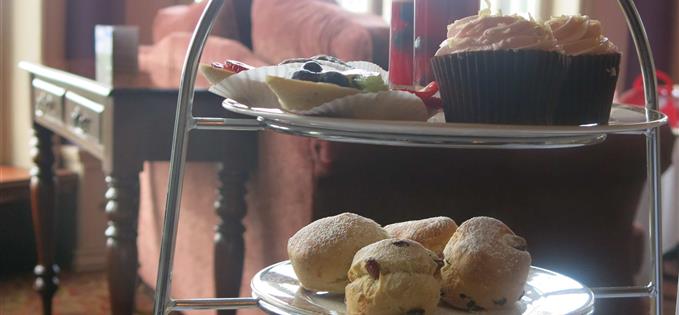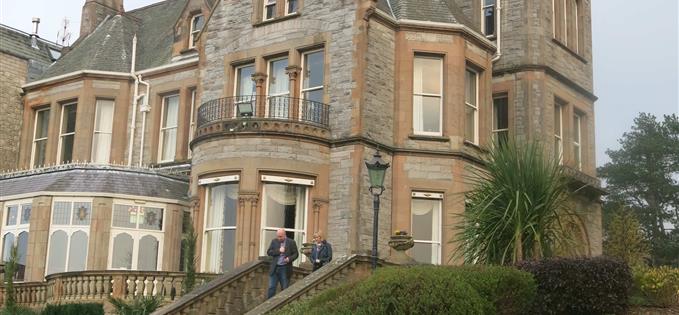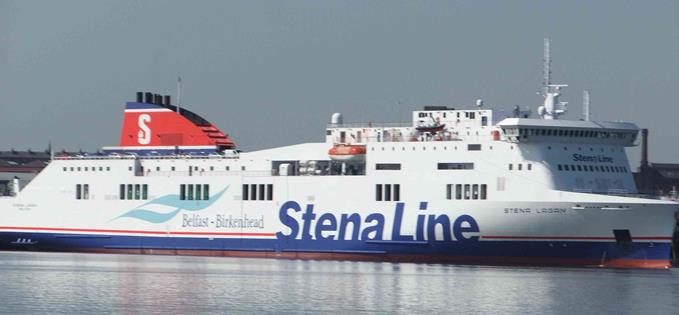I HAD considered the tall green hat and hook-on ginger beard option and decided I wasn’t going to go with the crowd on Paddy’s Day in Belfast. Driving up through Downpatrick, missing by minutes being marooned by their big parade, we had even seen a bull terrier painted bright emerald. Harbinger of a hoot of a night ahead. Even if Belfast is never as deliriously craiced up as Dublin on the big day, it’s not the place for a quiet drink, as we were to discover.

Not so long ago this was still very much a no-go area
We hadn’t given March 17 a thought when we arranged our Northern Ireland road trip. We’d even booked a meal in Belfast’s hottest city centre restaurant, The Ox, a 15 minute train ride from our base, the glorious 5-star Culloden Hotel.
Once the palace of the Bishops of Down, it sits imperiously in 12 acres of woodland overlooking Belfast Lough. Its calm contribution to St Patrick’s Day was to offer us a special cocktail with our cream tea in the drawing room.


May I introduce the Emerald Crush – Shortcross Gin (made by a couple in Downpatrick, serendipitously), orange bitters, lime juice and sugar syrup with the green element coming from a kiwi fruit muddle. Delicious with a crustless cucumber sandwich from the bottom tier of the tea spread.
Shortcross was on the bespoke botanicals menu at The Ox, where expectations were more than lived up to by the £45 five course tasting menu featuring scallops, venison, halibut and chateaubriand alongside a leftfield supporting cast of crapaudine beetroot, black garlic, bergamot and crosnes (OK I didn’t know either – it’s an edible tuber also known as the Chinese artichoke).

Chef Stephen Toman’s cuisine is a far remove from the Ulster fry and Irish stew that were traditional staple of the stevedores in the Harland and Wolff shipyards across the River Lagan. Oxford Street (hence The Ox) has its own scars of sectarian violence. 42 years ago, one summer afternoon, a car bomb exploded in the bus depot at one end of the street. Eleven people died and 40 were injured.
Not so long ago this was still very much a no-go area. Now regeneration is kicking in. It’s home to the landmark Waterfront Hall concert venue, St George’s Market and the Beacon of Hope sculpture, affectionately dubbed by locals “Nuala with the Hula” (pronounce it right and it rhymes). We looked out on it, lit-up, from the huge windows of the Ox – once a tile shop now transformed with an open plan kitchen, light blue painted walls and a soaring ceiling. It still has a new frontier feel, but you have to start somewhere.


These days on the surface the city has lost much of the desolate, threatening aura it had during the Troubles. It is, of course, a place to visit for major attractions such as Titanic Belfast, recreating the story of the doomed liner on the very slipways where it was built, and with increasing prosperity it seems bursting with projects to be proud of.
For our Paddy’s Day out, posh meal aside,we settled for the smaller pleasures, exploring the ramshackle cool of the ‘Cathedral Quarter’, one of the oldest parts of town. If the area around City Square was packed with cops supervising kids in green costume who had taken a drop too much, too early, the warren of bars and pop-ups around St Ann’s Cathedral boasted an older hipper, craic-seeking crowd. Creeping gentrification is a long way away from a city as unremittingly bashed about as Belfast, but the seeds are there, even if planted with a certain sardonic relief.



We made for the acclaimed music pub, the Duke of York in Commercial Court. A pub since 1810, in the Seventies it was severely bombed and when rebuilt lost its third storey. In 1998 it hosted Snow Patrol’s first ever gig (there’s a plaque). In March 2015 on Patrick’s night, it was buzzing outside, with great live music against a courtyard mural of iconic Irish heroes from Rory Gallagher to Seamus Heaney to some local footballer called Best.
We couldn’t leave Belfast without visiting its most iconic pub. On Great Victoria Street opposite the famously much-bombed Europa Hotel (like the Culloden part of the Hastings Group in these happier times) stands the gloriously ornate Crown Liquor Saloon (main picture above)

Leased by the National Trust to a pub group, it ought to feel preserved in aspic. Maybe in London, but not here where a roaring good time was being had by all, fuelled by Guinness and real ales from local microbrewery Whitewater. We ended up sharing a booth with the road crew from Opera North, refreshing themselves substantially after erecting the La Traviata set in the Grand Opera House.
Two miniatures of Bushmills awaited us at our bedside in the Culloden, but we resisted. After St Patrick’s night out in Belfast they might have been one wee nip too far.
Look out for Part 2 of Neil Sowerby’s Irish Odyssey: Coast roads and Game of Thrones.

Where else to drink?
Kelly’s Cellars dating back to 1720, is one of Belfast’s oldest bars, surviving in the midst of high-rise developments and hosting traditional music sessions
30-32 Bank Street, BT1 1HL.
Madden’s Bar, around the corner from Kelly’s is also a mecca for trad music lovers and Wednesday night, for the really committed there are set dancing lessons. Food again is on the limited side.
74 Berry St, BT1 1JE.
Sunflower, on the edge of the Cathedral Quarter, is altogether funkier, a conversion of an old bar into an eclectic live music venue and craft beer mecca (try the Cloughmore Dark Water Stout).
65 Union Street, BT1 2JG.
More Information
Staying there
The Hastings Hotel Group has six luxurious hotels across Northern Ireland. Neil Sowerby stayed in three of them during his Northern Ireland road trip. The Culloden was his Belfast base
Culloden Estate & Spa, Belfast, Bangor Road, Holywood, Belfast, BT18 0EX
Slieve Donard Resort & Spa, Downs Road, Newcastle, Co. Down, BT33 0AH
Ballygally Castle, Coast Road, Ballygally, Co. Antrim, BT40 2QZ
Hastings are particularly keen to promote their hotels as family-friendly destinations, offering rooms at Ballygally Castle from £150 per night, the (particularly family-friendly) Slieve Donard from £170 a night and The Culloden from £225 per night. Priced on a B&B basis with 2 adults and 2 children sharing. For further information ring 028 9047 1066. We were lucky enough to stay in suites at the hotels – respectively, the Slieve Martin, the Muirfield and Antrim – which cost considerably more, but each of which was a joy to stay in.
For Northern Ireland tourism information visit this link.

Getting there
Neil Sowerby took his own car to Ireland via the the Stena Lines Liverpool (Birkenhead)-Belfast ferry service. The return trip costs from £129 each way. It takes eight hours, so if you are going overnight you might want to book a cabin. Very handy access to motorways once you get off at Belfast. The Stena Lagan has been recently refurbished and boasts a smart bar/restaurant the Metropolitan Grill and Bar plus a further comforable lounge space, Barista Coffee. The Stena Plus lounge is available as part of the Premium fare, which also includes express boarding and disembarkation, or you may upgrade when onboard for only £20 per person (lounge access only). On board offers on designer fragrances, electronics, gifts and confectionery, save up to 50 per cent on high street prices.
For further details and to book visit this link.











